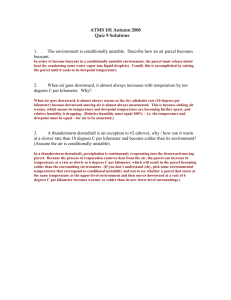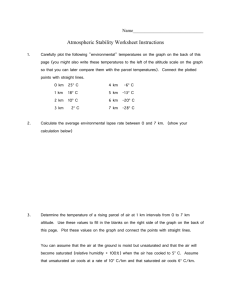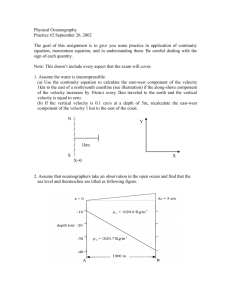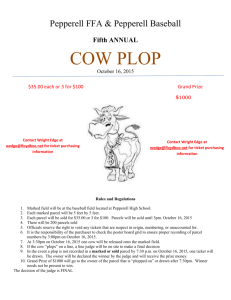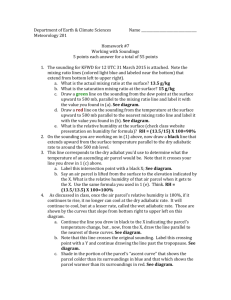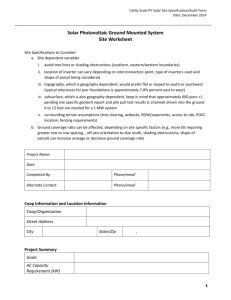Atmospheric Stability and Instability
advertisement
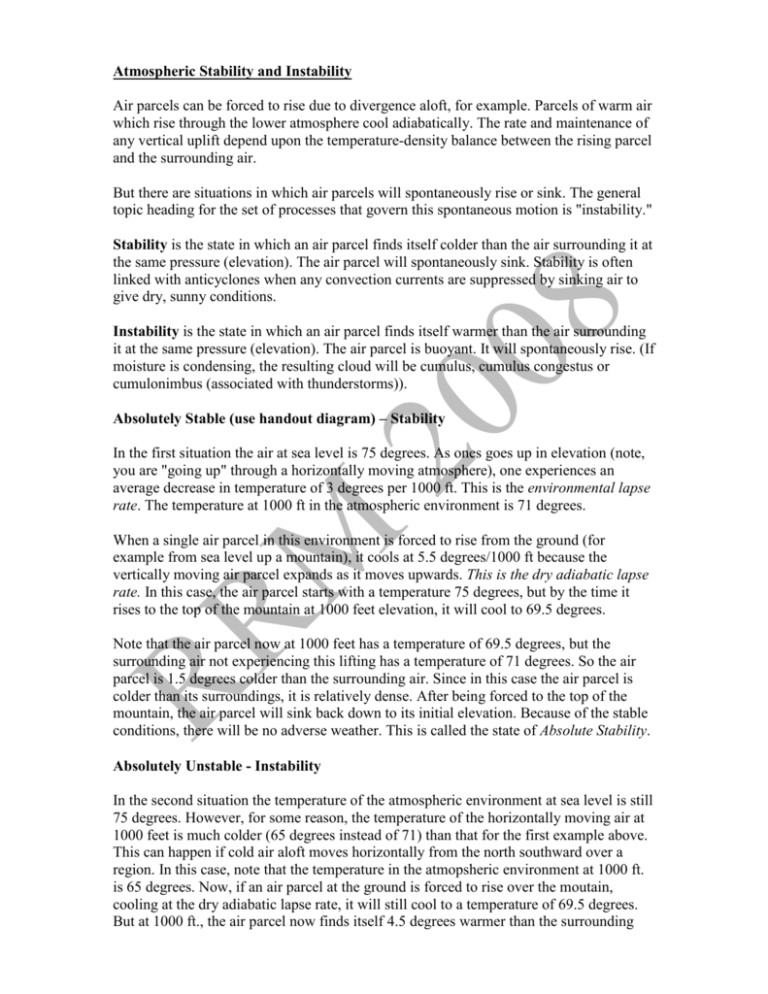
Atmospheric Stability and Instability Air parcels can be forced to rise due to divergence aloft, for example. Parcels of warm air which rise through the lower atmosphere cool adiabatically. The rate and maintenance of any vertical uplift depend upon the temperature-density balance between the rising parcel and the surrounding air. But there are situations in which air parcels will spontaneously rise or sink. The general topic heading for the set of processes that govern this spontaneous motion is "instability." Stability is the state in which an air parcel finds itself colder than the air surrounding it at the same pressure (elevation). The air parcel will spontaneously sink. Stability is often linked with anticyclones when any convection currents are suppressed by sinking air to give dry, sunny conditions. Instability is the state in which an air parcel finds itself warmer than the air surrounding it at the same pressure (elevation). The air parcel is buoyant. It will spontaneously rise. (If moisture is condensing, the resulting cloud will be cumulus, cumulus congestus or cumulonimbus (associated with thunderstorms)). Absolutely Stable (use handout diagram) – Stability In the first situation the air at sea level is 75 degrees. As ones goes up in elevation (note, you are "going up" through a horizontally moving atmosphere), one experiences an average decrease in temperature of 3 degrees per 1000 ft. This is the environmental lapse rate. The temperature at 1000 ft in the atmospheric environment is 71 degrees. When a single air parcel in this environment is forced to rise from the ground (for example from sea level up a mountain), it cools at 5.5 degrees/1000 ft because the vertically moving air parcel expands as it moves upwards. This is the dry adiabatic lapse rate. In this case, the air parcel starts with a temperature 75 degrees, but by the time it rises to the top of the mountain at 1000 feet elevation, it will cool to 69.5 degrees. Note that the air parcel now at 1000 feet has a temperature of 69.5 degrees, but the surrounding air not experiencing this lifting has a temperature of 71 degrees. So the air parcel is 1.5 degrees colder than the surrounding air. Since in this case the air parcel is colder than its surroundings, it is relatively dense. After being forced to the top of the mountain, the air parcel will sink back down to its initial elevation. Because of the stable conditions, there will be no adverse weather. This is called the state of Absolute Stability. Absolutely Unstable - Instability In the second situation the temperature of the atmospheric environment at sea level is still 75 degrees. However, for some reason, the temperature of the horizontally moving air at 1000 feet is much colder (65 degrees instead of 71) than that for the first example above. This can happen if cold air aloft moves horizontally from the north southward over a region. In this case, note that the temperature in the atmopsheric environment at 1000 ft. is 65 degrees. Now, if an air parcel at the ground is forced to rise over the moutain, cooling at the dry adiabatic lapse rate, it will still cool to a temperature of 69.5 degrees. But at 1000 ft., the air parcel now finds itself 4.5 degrees warmer than the surrounding air. Thus air parcel will be less dense than the air surrounding at 1000 feet and will continue to rise. Because the air body is now moving upward there will be adverse conditions. This is called the state of Absolute Instability. Conditionally Unstable – this type of instability occurs when the ELR is lower than the DALR but higher than the SALR In the third situation, the temperature in the atmospheric environment is still 75 degrees at sea level but is 70 degrees at 1000 ft. Note that the only constraint we have changed in discussing these three "states" is the temperature at 1000 feet. Thus, the temperature difference between the ground and 1000 feet observed by a thermometer as it is carried upwards in a weather balloon would be different on each of these days. If one air parcel is forced to rise to the top of the mountain, note that its temperature would still cool to 69.5 degrees, and it would still be colder than the surrounding air. In the atmosphere, this occurs if the dew point temperature in the air parcel is so low, that it would not be cooled to the dewpoint when lifted to 1000 feet elevation. This is still an absolutely stable atmosphere. However, suppose that surface dew point temperature was not low, and was also 75 degrees. The air parcel then would have a relative humidity of 100%. Condensation would be occurring, latent heat would be "released" and the air parcel, in rising, would cool not at the rate of 5.5 degrees per 1000 feet, but at the rate of 3.5 degrees per 1000 feet (the "wet" adiabatic rate). In this circumstance, the air parcel would cool to 71.5 degrees by the time it achieved an elevation of 1000 feet, and would therefore be 1.5 degrees WARMER than the air around it. The air parcel would be buoyant; this is called the state of Conditional Instability. (The adjective conditional is used because the air parcel will be unstable only if saturation occurs (100% RH) initially or at some point along its path and if the air parcel is forced to rise to the point where it will become warmer than its surroundings. Note: the two "ifs" are "conditions"). Observations show that absolutely unstable conditions occur in the atmosphere very rarely, if at all. On the other hand, thunderstorms occur daily around the world somewhere. That is because the atmosphere is conditionally unstable in these areas. Since the tendency for air to be conditionally unstable is directly related to how much water vapor is found at the surface, we have now explained why meteorologists often look for areas of high surface dew point temperatures as a "first guess" for areas that are liable to be prone to thunderstorm development. That is because these regions are usually strongly conditionally unstable as explained above. Finally, since tropical ocean areas are most often characterized by high dew points at the surface, cloud systems that develop in association with upper divergence are often cumuliform. This is why bands of thunderstorms form in tropical cyclones and hurricanes.



